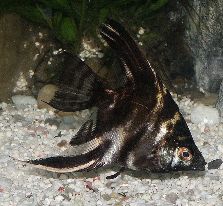Angelfish Cichlid
(Pterophyllum Scalare)
 Angelfish Cichlid (Pterophyllum Scalare) |
Size: Can grow to 8 inches Temp Range: 75°F to 86°F pH Level: 6.0 to 8.0 Lifespan: 5 to 9 years Tank Size: 40 gallons Diet: Pellet, Flake, Live, Frozen Difficulty: Moderate |
Geographic History
These regal looking Cichlids come from the Amazon River basin of Peru, French Guiana, Guyana, Columbia, and Brazil. They are typically found in swamps and flooded areas where the water is clear or slightly silty.
Enviornment
Angelfish require at least 15 inches of water column because they grow tall rather than long. They prefer soft substrate as they sift the bottom when grazing for food. You should plant the sides and rear of your aquarium and provide plenty of swimming room. Make sure you have good filtration because these fish need well maintained water quality.
Compatibility
Less aggressive South American Cichlids get along very well with these fish. Do not keep with fish smaller than two inches, they will be eaten. Also, don't keep any small, aggressive fin nippers with your Angelfish.
Sexing
It can be very hard to sex these guys. The best way is to observe their breeding tubes during spawning. Males have smaller breeding tubes than the females. A less accurate way to distinguish between the sexes is to look for a slight nuchal hump on the head of adult males.
Behavior
These are fairly peaceful fish. When kept in breeding pairs, they can become aggressive during spawning. If you add more than one to an aquarium smaller than 40 gallons, they will feel cramped and be aggressive toward each other. They are best kept in male/female pairs.
Breeding
Spawning pairs form long term relationships and will protect each other as well as their fry. They will reach sexual maturity at six to twelve months. When the eggs are removed from the spawning tank, mated pairs are capable of spawning every seven to ten days. At around three years of age, spawning frequency falls off until it eventually stops.
Spawning pars clean vertical surfaces off by picking away debris and algae before their eggs are laid. The female will deposit a line of eggs and the male will follow her fertilizing them. They will repeat this process in several places, laying around 1200 eggs. both fish fan their pectoral fins to move water over the eggs. They may eat eggs that are dead or unfertilized. After a few days, the eggs hatch. The fry will swim about a week later, eating baby brine shrimp and crushed flake food.
It is important to keep excellent quality water as the fry grow to juveniles. Do daily 10% water changes to achieve this. Also note that any other fish in the aquarium with the fry run the risk of being aggressed by the parents. They are very protective of their young.
For more information, go to Wikipedia's Angelfish page.





